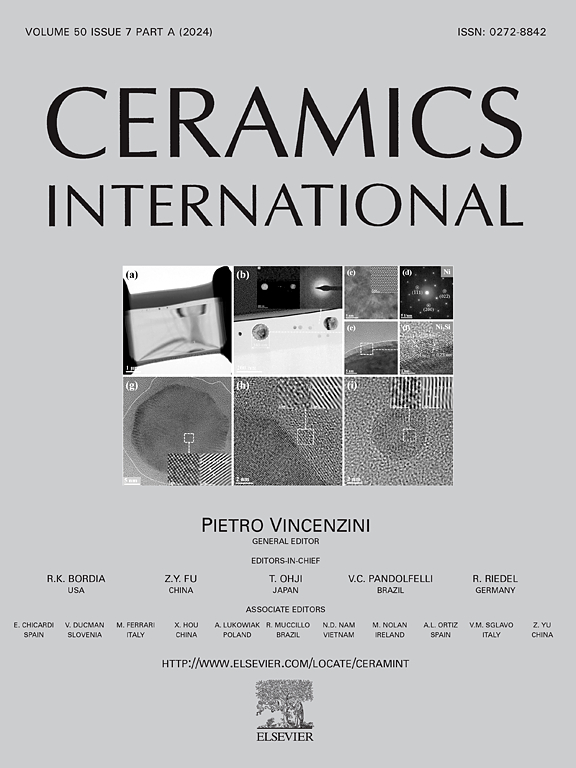以工业硫酸钛溶液为原料制备电子级高比表面积水合二氧化钛的新工艺
IF 5.6
2区 材料科学
Q1 MATERIALS SCIENCE, CERAMICS
引用次数: 0
摘要
以工业TiOSO4溶液为原料,通过调整水解条件制备出具有电子级和高比表面积的水合二氧化钛,为其在高频电容器、陶瓷介质电容器、PTC热敏电阻等电子工业中的应用奠定了坚实的基础。考察了TiO2总浓度和Fe/TiO2比等水解条件对水合二氧化钛的组成和结构的影响。总TiO2浓度和Fe/TiO2比影响水合二氧化钛的成核、结晶、生长和聚集,导致晶体尺寸的变化,进而影响其粒径分布、杂质含量、水合二氧化钛的比表面积。高Fe/TiO2比导致含水二氧化钛晶体结构的各向异性收缩,使其晶面间距减小。在具有螯合双齿配位结构的硫酸盐离子与水分子相互作用下,含水二氧化钛颗粒积聚形成孔隙结构。当TiO2总浓度为160 ~ 170 g/L, Fe/TiO2比为0.53时,可制得电子级水合二氧化钛,比表面积为328 m2/g,中位粒径为0.89 μm, TiO2含量为99.78%。本文章由计算机程序翻译,如有差异,请以英文原文为准。
Novel route to prepare hydrous titania with electronic grade and high specific surface area from industrial titanyl sulfate solution
Hydrous titania with electronic grade and high specific surface area was prepared by adjusting hydrolysis conditions from industrial TiOSO4 solution, establishing solid foundation for its application in electronics industry such as high-frequency capacitors, ceramic dielectric capacitors, and PTC thermistors, etc. The effects of hydrolysis conditions such as total TiO2 concentration and Fe/TiO2 ratio on the compositions and structures of hydrous titania were investigated. The total TiO2 concentration and Fe/TiO2 ratio affected the nucleation, crystallization, growth and aggregation of hydrous titania, resulting in changes in the crystal size, subsequently affecting its particle size distribution, impurity content, specific surface area for the hydrous titania. High Fe/TiO2 ratio led to anisotropic shrinkage of the crystal structure for hydrous titania, and reduced its crystal plane spacing. Under the interaction between sulfate ions with chelating bidentate coordination structure and water molecules, the hydrous titania particles accumulated to form the pore structure. When the total TiO2 concentration was of 160-170 g/L and the Fe/TiO2 ratio of 0.53, electronic grade hydrous titania could be produced with specific surface area of 328 m2/g, median diameter size of 0.89 μm, TiO2 content of 99.78 %.
求助全文
通过发布文献求助,成功后即可免费获取论文全文。
去求助
来源期刊

Ceramics International
工程技术-材料科学:硅酸盐
CiteScore
9.40
自引率
15.40%
发文量
4558
审稿时长
25 days
期刊介绍:
Ceramics International covers the science of advanced ceramic materials. The journal encourages contributions that demonstrate how an understanding of the basic chemical and physical phenomena may direct materials design and stimulate ideas for new or improved processing techniques, in order to obtain materials with desired structural features and properties.
Ceramics International covers oxide and non-oxide ceramics, functional glasses, glass ceramics, amorphous inorganic non-metallic materials (and their combinations with metal and organic materials), in the form of particulates, dense or porous bodies, thin/thick films and laminated, graded and composite structures. Process related topics such as ceramic-ceramic joints or joining ceramics with dissimilar materials, as well as surface finishing and conditioning are also covered. Besides traditional processing techniques, manufacturing routes of interest include innovative procedures benefiting from externally applied stresses, electromagnetic fields and energetic beams, as well as top-down and self-assembly nanotechnology approaches. In addition, the journal welcomes submissions on bio-inspired and bio-enabled materials designs, experimentally validated multi scale modelling and simulation for materials design, and the use of the most advanced chemical and physical characterization techniques of structure, properties and behaviour.
Technologically relevant low-dimensional systems are a particular focus of Ceramics International. These include 0, 1 and 2-D nanomaterials (also covering CNTs, graphene and related materials, and diamond-like carbons), their nanocomposites, as well as nano-hybrids and hierarchical multifunctional nanostructures that might integrate molecular, biological and electronic components.
 求助内容:
求助内容: 应助结果提醒方式:
应助结果提醒方式:


